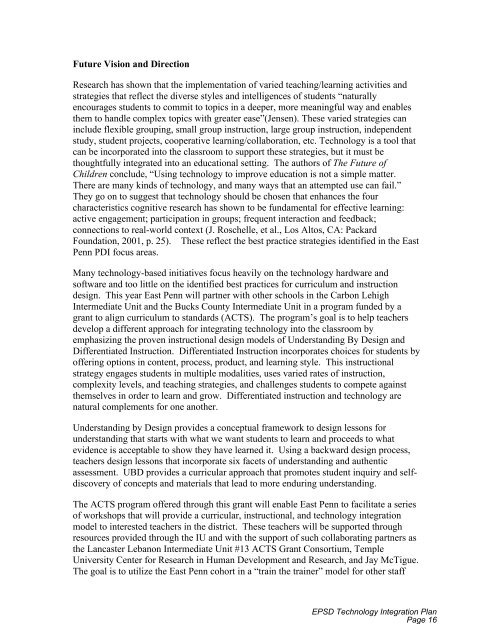EPSDtechintplan2004
EPSDtechintplan2004
EPSDtechintplan2004
Create successful ePaper yourself
Turn your PDF publications into a flip-book with our unique Google optimized e-Paper software.
Future Vision and Direction<br />
Research has shown that the implementation of varied teaching/learning activities and<br />
strategies that reflect the diverse styles and intelligences of students “naturally<br />
encourages students to commit to topics in a deeper, more meaningful way and enables<br />
them to handle complex topics with greater ease”(Jensen). These varied strategies can<br />
include flexible grouping, small group instruction, large group instruction, independent<br />
study, student projects, cooperative learning/collaboration, etc. Technology is a tool that<br />
can be incorporated into the classroom to support these strategies, but it must be<br />
thoughtfully integrated into an educational setting. The authors of The Future of<br />
Children conclude, “Using technology to improve education is not a simple matter.<br />
There are many kinds of technology, and many ways that an attempted use can fail.”<br />
They go on to suggest that technology should be chosen that enhances the four<br />
characteristics cognitive research has shown to be fundamental for effective learning:<br />
active engagement; participation in groups; frequent interaction and feedback;<br />
connections to real-world context (J. Roschelle, et al., Los Altos, CA: Packard<br />
Foundation, 2001, p. 25). These reflect the best practice strategies identified in the East<br />
Penn PDI focus areas.<br />
Many technology-based initiatives focus heavily on the technology hardware and<br />
software and too little on the identified best practices for curriculum and instruction<br />
design. This year East Penn will partner with other schools in the Carbon Lehigh<br />
Intermediate Unit and the Bucks County Intermediate Unit in a program funded by a<br />
grant to align curriculum to standards (ACTS). The program’s goal is to help teachers<br />
develop a different approach for integrating technology into the classroom by<br />
emphasizing the proven instructional design models of Understanding By Design and<br />
Differentiated Instruction. Differentiated Instruction incorporates choices for students by<br />
offering options in content, process, product, and learning style. This instructional<br />
strategy engages students in multiple modalities, uses varied rates of instruction,<br />
complexity levels, and teaching strategies, and challenges students to compete against<br />
themselves in order to learn and grow. Differentiated instruction and technology are<br />
natural complements for one another.<br />
Understanding by Design provides a conceptual framework to design lessons for<br />
understanding that starts with what we want students to learn and proceeds to what<br />
evidence is acceptable to show they have learned it. Using a backward design process,<br />
teachers design lessons that incorporate six facets of understanding and authentic<br />
assessment. UBD provides a curricular approach that promotes student inquiry and selfdiscovery<br />
of concepts and materials that lead to more enduring understanding.<br />
The ACTS program offered through this grant will enable East Penn to facilitate a series<br />
of workshops that will provide a curricular, instructional, and technology integration<br />
model to interested teachers in the district. These teachers will be supported through<br />
resources provided through the IU and with the support of such collaborating partners as<br />
the Lancaster Lebanon Intermediate Unit #13 ACTS Grant Consortium, Temple<br />
University Center for Research in Human Development and Research, and Jay McTigue.<br />
The goal is to utilize the East Penn cohort in a “train the trainer” model for other staff<br />
EPSD Technology Integration Plan<br />
Page 16


